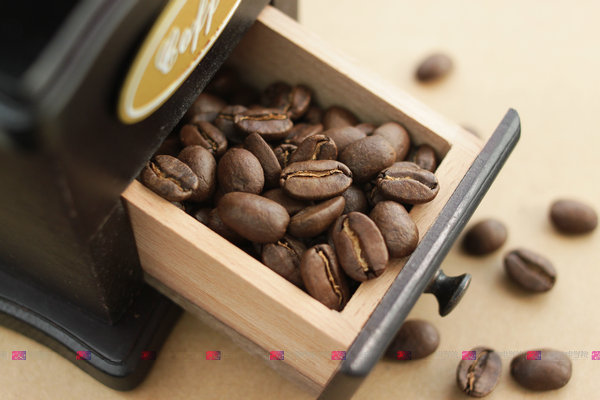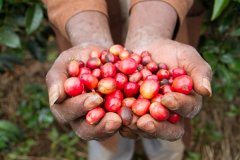How to choose the variety and proportion of coffee beans when blending coffee beans?

[FelixLin's answer (14 votes)]:
Thank you for the invitation! In terms of personal experience, I generally follow the principle of sweet and sour balance, that is, no matter what kind of beans, or what kind of baking degree, I will first test these beans, feel the sweet and sour feeling of coffee beans!
If you give me two coffee beans now, then I will first test the sweet and sour feeling of these two coffee beans, then use a spoon to take a certain proportion to taste, and then find out the proportion when the two beans reach the balance between sour and sweet. Then use a coffee machine to extract, because people's taste buds have different sensitivity to sweet and sour taste, so the proportion needs to be fine-tuned after extraction with a coffee machine. Finally, the proportion of the coffee machine after adjustment shall prevail.
It should be noted that we should also take into account the performance of the coffee machine and the bean grinder. If the coffee machine with low extraction rate, it will be slightly sour, and the acidity will be stronger in Italian concentration, so when measuring the cup, we will try to reduce some acidity and make it a little sweeter, so that the extracted espresso will not be so sour, so as to achieve the effect of sweet and sour balance.
Blending does not force the use of any coffee beans, all need to taste to achieve the appropriate effect, the blending process, as mentioned above, when you can take the initiative to choose coffee beans, it is common to choose a bean with a strong flavor as the flavor core of the mixed bean, and use a bean that is not very strong but with high sweetness to balance the sour taste of the flavor bean, because a good flavor means a certain acidity. Then use a bean with rich fat but less flavor to strengthen the alcohol thickness of this blend. In this case, the more suitable way to match is to choose three beans, no matter how many beans are more experienced and more complicated, so don't be so complicated at the beginning of the match.
In this way, the selection of the proportion and baking degree of the three beans need to be familiar with the beans, use the cup test to find the approximate proportion, and finally use the machine to test, so as to determine the final proportion.
It's a tedious process, but it's fun, because when you drink an espresso whose flavor is determined by yourself, it feels great.
[answer from Oreo at the seaside (0 votes)]:
Amateur professionals mix beans with a variety of recipes. I like to divide it into two kinds of espresso and milk coffee, as well as a single formula (which can be a single product with a uniform baking degree or a single product mixture with different baking degrees. Generally speaking, I can't drink it, just for the competition. The cost is too high) only as the formula of espresso is bound to take into account the characteristics of this bean, domestic delicious espresso is really difficult to find. It is generally composed of more than three kinds of beans, and the larger ones are Brazil, Colombia, Mantenin, etc., plus other producing areas of South America and a small amount of African beans (to increase flavor). Adjust the proportion and baking degree according to the actual situation. The formula of milk coffee must consider the taste after combining with milk, generally pay attention to chocolate taste. The taste should be relatively heavy, otherwise the coffee will not taste enough when combined with milk.
In brief, the door of baking is very deep. Keep learning, at present, the best drink is the intellectuals' rich black cat fat. Nowadays, boutique coffee hates using turnip beans, but many big-name recipes in Europe still contain radish beans. I think it is king if it tastes good. I don't really care)
[answer by Chen Sicong (0 votes)]:
Different coffee beans have different flavors, depending on their producing areas, processing methods, etc., generally speaking, Latin American coffee beans are more smooth, acidity is more obvious than alcohol, represented by Guatemala beans, mostly for washing, the outer skin of coffee fruit is washed, and the acidity is fermented. On the other hand, the African region, represented by Kenya, has a berry flavor because its processing method is naturally dry, and the outer skin of the coffee fruit has not been removed, and the berry flavor will naturally infiltrate into it. Asian beans represented by Sumatran beans are mellow higher than acidity, that is, we often say bitter, Asian beans are mostly mixed with the taste of soil, herbal flavor. As for matching, there are two kinds, one is to first bake and then mix, the baked beans have their own flavor and then mixed, the taste buds of different stages will have different feelings, generally this kind of matching is mostly, the purpose is to match the appropriate coffee beans according to different needs and different tastes you want to achieve. Mixing and baking is generally not as rich as the former. Beans with different baking degrees will bring different feelings at different stages in the mouth, which is probably the choice of matching. For example, the beans of Guatemala and Sumatra are roasted separately and then mixed, and the entrance will be smoother (Guatemala). But the tongue pressure will be heavier (Sumatra). Among the more common mixed beans, aged Sumatran beans are one kind.
Original address: Zhihu
Important Notice :
前街咖啡 FrontStreet Coffee has moved to new addredd:
FrontStreet Coffee Address: 315,Donghua East Road,GuangZhou
Tel:020 38364473
- Prev

Coffee bean roasting system transformed from popcorn machine
Transformation materials: 1, small popcorn machine, plus postage 90 yuan to have change. 2. The aluminum foil cover, which is instead of the original plastic windshield, could not withstand a high temperature of more than 200 degrees Celsius and melted during the test. 3. Arduino controller. 4. Temperature sensor module, which is used to monitor the real-time temperature inside the machine. 5. Relay module. Used to control the current on and off. 6. No
- Next

Three native species of coffee: Arabica, Robusta and Liberia
Coffee belongs to the evergreen shrub of the genus Rubiaceae, which is centered in the tropics. There are about 6000 species of Rubiaceae belonging to 500 genera. Coffee has always been considered to have certain effects, such as invigorating the stomach, waking up the brain, stopping bleeding, dissipating heat, strengthening the body and so on. There are about 40 species of coffee plants, but the only ones that can produce coffee beans of commercial value are Arabica, Robusta and Libby.
Related
- Guji coffee producing area of Guji, Ethiopia: Humbela, Shakiso, Wulaga
- What is the most expensive variety of Qiloso in BOP multi-variety group?
- How to store the coffee beans bought home?
- Why are Yemeni coffee beans so rare now?
- Ethiopian Sidamo all Red Fruit Sun Sun Santa Vini Coffee beans
- SOE is mostly sour? What does it mean? Is it a single bean? what's the difference between it and Italian blending?
- Is Italian coffee beans suitable for making hand-brewed coffee?
- How to choose coffee beans when making cold coffee? What kind of coffee beans are suitable for making cold coffee?
- Just entered the pit to make coffee, what kind of coffee beans should be chosen?
- Can only Japan buy real Blue Mountain Coffee? What are authentic Jamaican Blue Mountain coffee beans?

